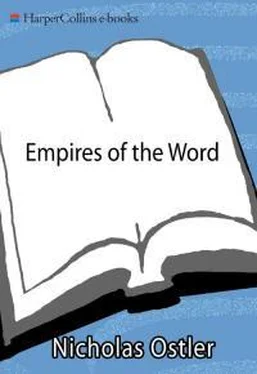In fact, this word is borrowed from Germanic. Besides breeks or britches , it underlies the Celtic word for footwear, brogues.
Such differences would in fact not be sought until 1599, when Joseph Justus Scaliger classified Latin, Greek, Germanic and Slavonic languages through their different words for God.
The Boii were well known as a far-flung tribe of Gauls, having connections with Bohemia (etymologically ‘Boii-home’, though in Germanic not Celtic) and having a major settlement in north-eastern Italy (around such modern cities as Bologna, Parma and Modena). Somehow they also showed up as allies of the Helvetii in southern Gaul, and were defeated by Caesar at Bibracte in 58 BC. The name means ‘hitters’, according to Lambert (1997: 44).
How they were related to the Celts in western Europe is quite unclear. Yugoslavia and Hungary are in fact the heart of the so-called Urnfield culture, dated by archaeologists to the first half of the first millennium BC, and so preceding the high points of Hallstatt and La Tène. The Urnfield culture had been on the path of the spread of Iron Age civilisation from the Aegean; and so it is quite possible that Celts had been in this area even longer than in western Europe. But as historians of Celtic-language speakers, we can only be agnostic about the link to these prehistoric material cultures.
In fact, few linguists today take this P/Q criterion as a very strong discriminant. The change could happen anywhere: indeed it has, in modern Romanian, and quite independently in the Italic dialects (e.g. Oscan changed to P, Latin didn’t). And even in the centre of the P-dialects, not all Qs changed to P: on the Coligny calendar in the Rhône valley we find EQVOS, EQVI, ‘horse’ (even though the usual Gaulish name for the horse goddess is Epona), and the ‘Sequani’, living on the river ‘Sequana’ (Seine) in northern Gaul, seem unaffected. But P-Celtic and Q-Celtic are such a chestnut in the tradition that it seems deceptive to leave it out of the discussion.
(These asterisks show forms that have been reconstructed by linguists, but are not actually found in some text.)
This absence of P is not as strange as it might seem. It also seems to have afflicted the indigenous language of Iberia, and even early Basque, and is typical too of modern Arabic. But Celtic did not remain a totally P-less language for long. At least some of its variants, including most dialects of Gaulish, and also British (leading to modern Welsh, Cornish and Breton), later started to pronounce the sound qu- as p. Hence its presence in the words for four and five ( pedwar and pump in modern Welsh, probably *petuar and *pinpe in Gaulish, on the evidence of some kiln records, mentioned in note 22 on p. 566). As a result, where initial qu- had been the mark of question words in the original language (cf. Latin’s conservative quis, quid, quando , ‘who, what, when’), initial p- has this role in this variety of Celtic language (cf. Welsh pwy, pa, pam , ‘who, which, why’, and presumably much the same in Gaulish). The other Celtic languages also changed the qu-, but just simplified it to a k- sound. Hence Irish ceilhir, cóic (’four, five’), and cé, cad, cá (’who, what, where’). What evidence there is for Celtiberian suggests it was more like Irish than Gaulish in this respect.
Compare these pronouns in Old English ( hē, hit, hēo, hīe ) with Old Norse ( hann, that, hon, their/thau/thær —using English th for the Norse ō ). Mix-ups between rather different systems of endings, well preserved in both Old English and Norse, may also have caused the breakdown of case marking for nouns.
The earliest known Etruscan inscriptions date from about a century earlier, c .700 BC. The Etruscans had themselves learnt how to write from the Greeks, though probably through contacts much farther south, round Cumae in the Bay of Naples.
Contrast Lusitanian, spoken farther south: we know hardly more than two words of this language, but those two words are enough to disqualify it as Celtic: porcom tavrom , ‘pig bull’. The first has a P; the second has its V and R in the wrong order: compare Gaulish tarvos. Old Irish tarb , Middle Welsh tarw.
By contrast, Germanic has the same underlying root for ‘bronze’ as Latin: Gothic aiz , Old English ār , Old High German ēr versus Latin aes , suggesting that this technology was already an established acquisition before the common ancestors of the Italic- and Germanic-speaking tribes went their separate ways.
Perhaps this is a glimpse of Gaulish with a Greek accent: the natural Gaulish for this would be Deiwo-tarwos , but Greek had dropped all [w].
Senators needed to be at least of equestrian rank, for which the qualification (in landed property) was set at 400,000 sestertii. Taking the 1879 valuation in Lewis and Short’s Latin Dictionary , and applying inflation rates since, this would equate to a present (2003) value of €186,000 or $315,000.
And just about the same time, Armenian was doing much the same thing with an infusion of Persian.
Names mentioned in Aquitanian inscriptions appear to have Basque roots, e.g. Cison, Andere, Nescato and Bihoxvs beside Basque gizon , ‘man’, andere , ‘lady’, neskato , ‘girl’, and bihotz , ‘heart’ (Gorrochategui 1995: 38).
Their ascendancy was notable for unending struggle against the Basques: each king making the proud, but apparently empty, boast in his annals ’domuit Vascones –he tamed the Basques’.
Strangely, Attila is really his nickname in Gothic, and means ‘Dad’.
Of these, only the language spoken by the Magyars is clear: it was Hungarian, related to the Uralian languages of northern Siberia. As for the others, Avar was probably a Mongol and Bulgar and Khazar Turkic languages. Old Avar does not seem to have been the same as what is now known as Avar, which is a language of the north-east Caucasus, spoken in Daghestan and Azerbaijan, and quite unrelated to Turkic. Bulgar may survive in scattered pockets across Siberia to this day, known as Chuvash. (This name is identical with Tabgach , the name of a people famous for their fourth-century conquest of northern China.) (See Chapter 4, ‘Language from Huang-he to Yangtze’, p. 140.) The Khazars ruled from the Caspian Sea to Kiev for a century ( c .650-750), and are chiefly famous for their choice of mass conversion to Judaism in 861. Today’s Karaim are their descendants. Another Turkic group, the Tatars of the Golden Horde, moved across in the thirteenth century.
Latin bore a charmed life in North Africa, for a century (428-533) under the Vandals, and then controlled by the Roman empire resurgent from Constantinople until 696. The career of the most famous resident, St Augustine (354-430), bishop of Hippo, would have been unthinkable outside a Latin-speaking milieu. Remarks he makes in some of his sermons provide evidence that bilingualism with Punic, the old language of Carthage, may have persisted until the fourth century (Sznycer 1996). Evidently the common people continued to speak Berber (as they do to this day). But the Arab takeover in the eighth century, backed up by the conversion to Islam of the Berber-speaking hinterland, would be much more quickly influential in changing the region’s working language than the Vandals had been (or perhaps even the Romans, in the 750 years since the destruction of the independent Carthage).
Читать дальше











